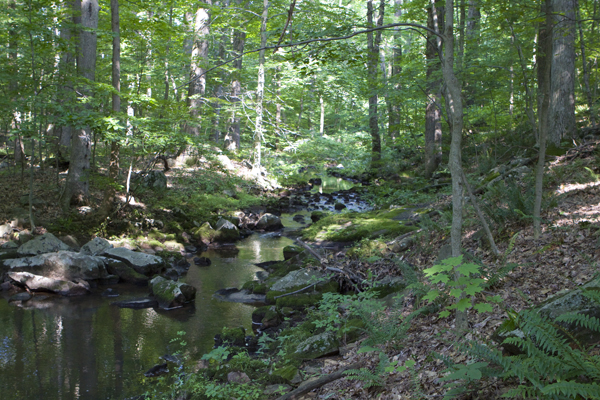
Alexauken Creek, West Amwell, NJ – healthy Category One stream buffer
[Update below]
The Department of Environmental Protection (DEP) provides enhanced regulatory protections for “exceptional” waters of the State, known as “Category One” or “C1” streams.
No disturbance of soils or vegetation is allowed by “major development” within a 300 foot wide vegetated stream buffer (on each side). Wide vegetated buffers protect water quality, provide plant and wildlife habitat, and reduce flooding risks.
On November 3, 2003 DEP proposed to classify the Alexauken Creek a C1 stream. No doubt, DEP considered the above stretch of the Alexauken in West Amwell. According to DEP:
Delaware River Basin: Alexauken Creek – The Department is proposing a Category One antidegradation designation for the entire length of the Alexauken Creek including all named and unnamed tributaries based on “exceptional ecological significance“. Data on the health of the benthic macroinvertebrate community in Alexauken Creek indicate low stress (non-impaired) to the aquatic community with a good diversity of intolerant organisms. The in-stream habitat quality assessment indicates an exceptional (optimal) habitat quality (see Table C). The Alexauken Creek received a good Fish IBI rating with 16 different species identified in the stream (see @ page 10-11)
The Alexauken C1 proposal was adopted on August 2, 2004. Only the NJ Builders Association opposed it.
So, it’s crazy that local farmers are allowed to ignore the importance of protected buffers and not only destroy stream vegetation, but graze cattle directly in the stream. This pollutes an important tributary to the Delaware River (upstream of Trenton’s water supply intake). It also increases flooding risks to downstream homes and the City of Lambertville.

cattle grazing in C1 stream and poor land management of buffer. Note how the buffer is clear-cut in the power line right of way

PSEG clearcuts vegetation in stream buffer, exacerbating erosion that ironically now threatens their own powerline
PSEG clear cuts vegetation in steep slopes in the stream buffer. This exacerbates soil erosion caused by grazing and poor farmland management practices:
Downstream of this farm, the flooding is made worse:
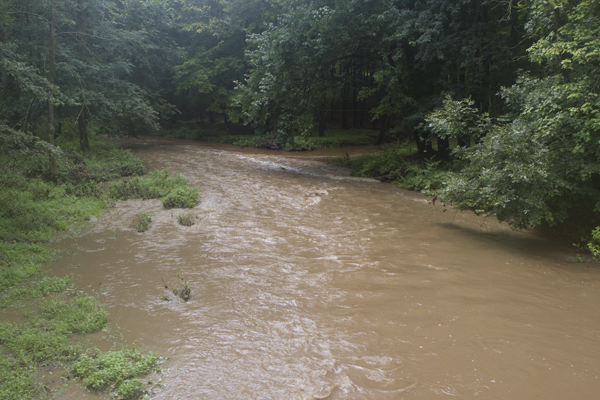
Alexauken floods after small rainfall (this is just feet downstream of farm depicted)
A a result, the banks of the Alexauken are severly eroding – compare the below eroded stretch of the stream to the forested buffers in top photo:
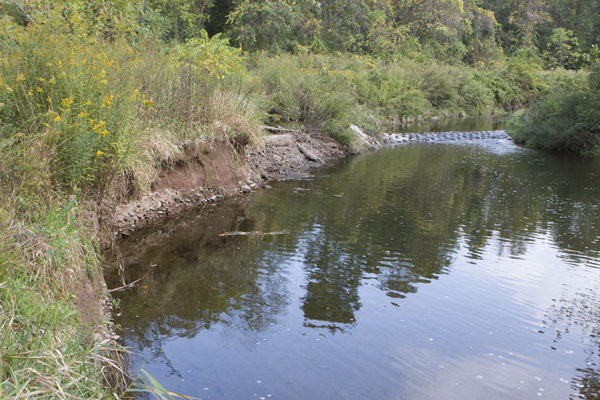
stream bank erosion caused by poor land use and poor land management
Here’s what the Alexauken looks like after intense rainfall (location of this photo is just upstream of the cattle shot, across the same farmer’s land):

Alexauken floods farmer’s land
Here is the Alexauken, flooding just downstream of this farm – flood waters wash out road and threaten bridge, imposing millions of dollars of costs on taxpayers to replace them:
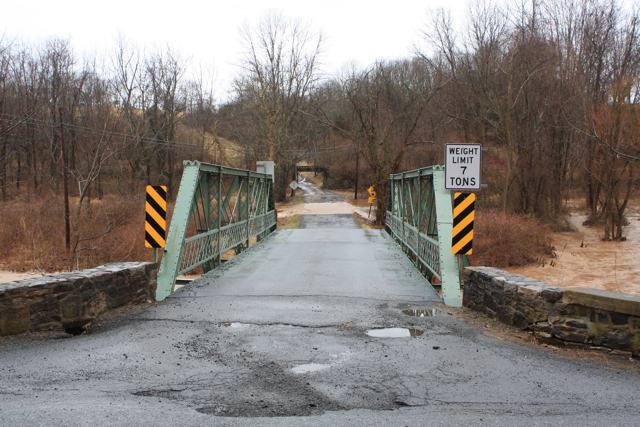
Alexauken flooding threatens to wash out road and bridge
Here’s where the Alexauken meets the Delaware inLambertville (after a small morning rain) – these tributaries make flooding far worse in Lambertville and Trenton:
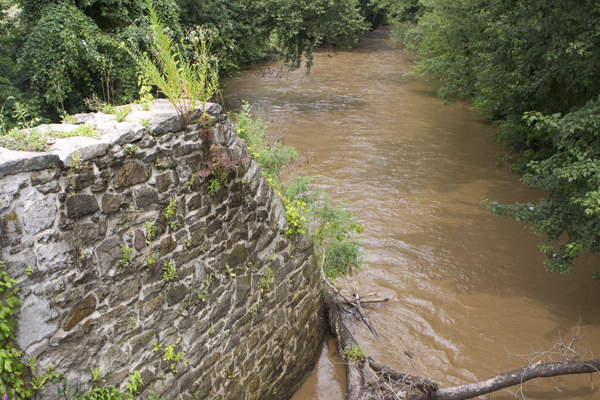
Alexauken near D&R Canal and Delaware River just north of Lambertville
If one looks closely at the pictures of the cattle in the stream, one will note the footings of a major power transmission line. Note how the stream bank is eroding, thus jeopardizing the structural integrity of the power transmission line. Does PSEG care about land management threat to it’s power lines?

poorly managed land, grazing cattle in stream cause erosion that threatens power transmission tower
[Update: 10/20/15 – just came across this gem of a statement by PSEG in a Susquehanna Roseland power line BPU petition – check i out in light of the above photo:
For the most part, it is my understanding that structure replacement will take place within the existing Right-of-Way in as near a location as the existing structures, and thus there will be minimal net loss of wetlands or critical resources. In the isolated event that an additional pole must be placed in a critical area because of engineering constraints, the permanent impact will be isolated to the footprint of the structure base or foundation. Any permanent impacts will be mitigated in accordance with the applicable laws and regulations of the governing entity PSE&G has proposed alternative locations for both switching stations in an effort to reduce the environmental impacts. (@p.80) ~~~ end update]
So, if State regulators at DEP don’t give a damn about protecting water quality and reducing flooding risks, maybe the BPU or PSEG will step in. If I recall, a tree fell on a power line in Ohio and that resulted in a blackout in the entire northeast. What would hapen if this transmission tower were to fall? If anyone even mentioned doing such a thing, I’m sure the Homeland Security folks would view it as a “eco-terrorism” concern. Maybe we ought to consider poor land management and soil erosion as a form of domestic terrorism – they are doing far more harm than alleged terrorists.
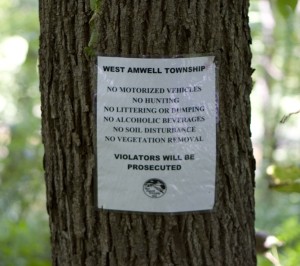
West Amwell Ordinance prohibits soil disturbance or destruction of vegetation in buffer
Grazing cattle in a C1 stream and PSEG practices of clear cutting vegetation in the protected stream buffer are unacceptable land management practices. We will bring this matter to the attention of all agencies with regulatory jurisdiction and an ability to stop it: DEP; Hunterdon County Soil Conservation District; State Agriculture Department; BPU; and West Amwell Township.
We’ll let you know about what we hear – but don’t hold your breath waiting for enforcement.

Pingback: WolfeNotes.com » My Well Went Dry Today
Pingback: WolfeNotes.com » Johanna Farms Flemington Stench Spreads to West Amwell
Pingback: tree felling Liverpool
Pingback: wildstar platinums
Pingback: cheap wow gold
Pingback: Quantum Vision
Pingback: roger vivier sale
Pingback: fitflop soldes
Pingback: nike blazers uk
Pingback: nike roshe run 3
Pingback: Roger Vivier flats
Pingback: louis vuitton nettbutikk
Pingback: www.tfou.no/in/fitflopsalg.asp
Pingback: fitflops norge
Pingback: شركة مكافحة حشرات بالرياض
Pingback: nike air max bw trainers
Pingback: nike air max usa
Pingback: pay4you
Pingback: ブランドスーパーコピー
Pingback: jag
Pingback: WolfeNotes.com » Take a Look At Christie DEP “Lowest Priority” Streams For Updating Flood Maps